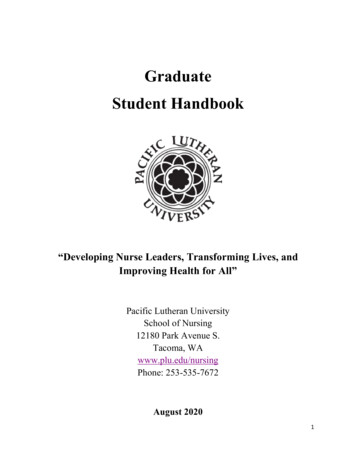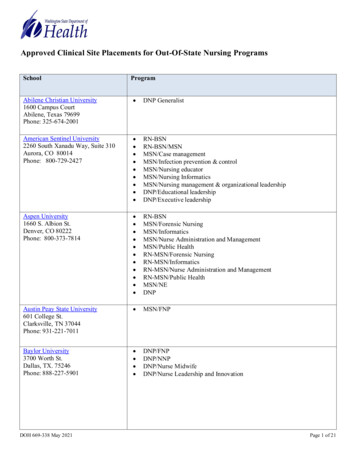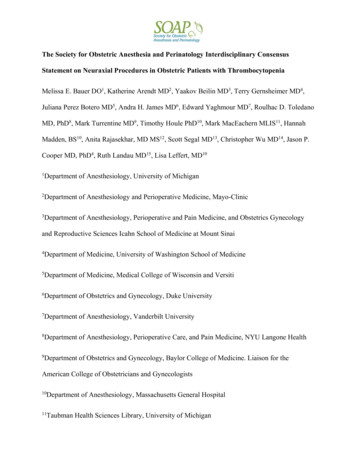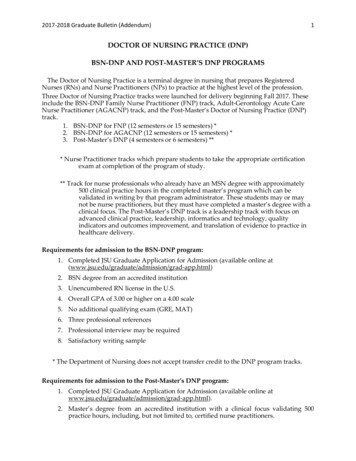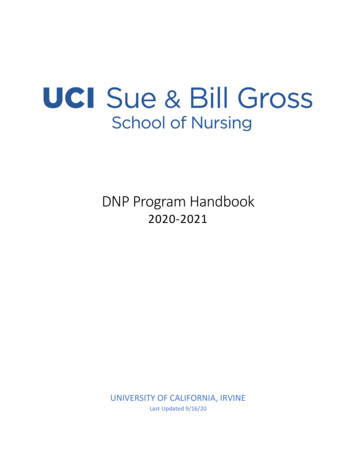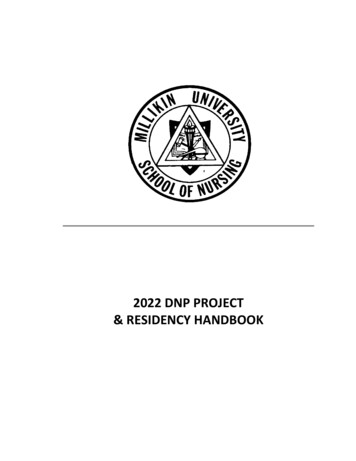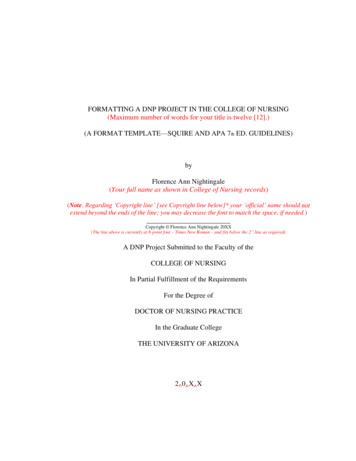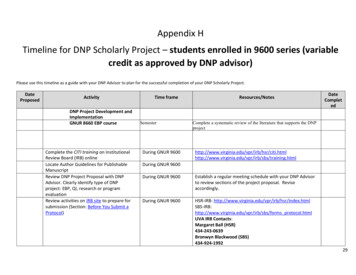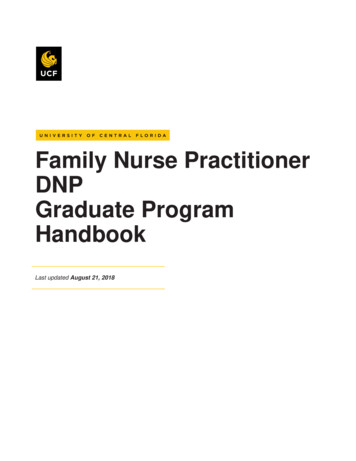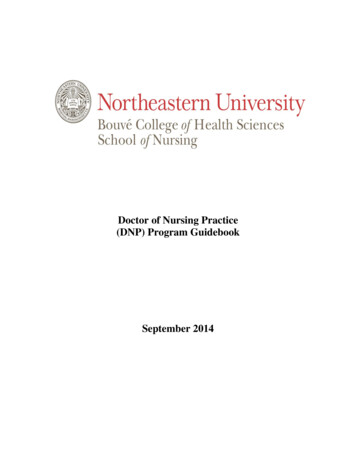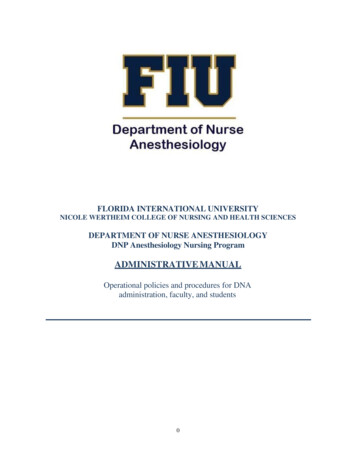
Transcription
FLORIDA INTERNATIONAL UNIVERSITYNICOLE WERTHEIM COLLEGE OF NURSING AND HEALTH SCIENCESDEPARTMENT OF NURSE ANESTHESIOLOGYDNP Anesthesiology Nursing ProgramADMINISTRATIVE MANUALOperational policies and procedures for DNAadministration, faculty, and students0
FLORIDA INTERNATIONAL UNIVERSITYNICOLE WERTHEIM COLLEGE OF NURSING AND HEALTH SCIENCESDEPARTMENT OF NURSE ANESTHESIOLOGYDNP Anesthesiology Nursing ProgramDNP in Nurse Anesthesia Student ContractI have been made aware of the online location of the Florida International University, AnesthesiologyNursing Program, Policy and Procedure Manual. I have had an opportunity to review and discuss itscontents. As a student enrolled in the DNP in Nurse Anesthesia, I agree to abide by and respect thepolicies, regulations, procedures, and standards outlined in this handbook. I understand that thesepolicies, regulations, procedures, guidelines, and standards are subject to change as deemed necessaryby the University, College of Nursing, or the Program. Any changes to these may be sent via emailwith high-priority notifications. By opening the email, I verify that I have been notified of thechange.Likewise, during the clinical phase of the program, it is essential to the success of clinical rotations toaccess and read emails within 24 hours from the program, and clinical sites and complete all requiredcredentialing paperwork. Failure to read high-priority emails sent from the University, College, DNPin Nurse Anesthesia, and/or clinical sites is considered negligent and grounds for disciplinary action.I understand it is my responsibility to access my FIU email account daily, read all program-relatedemails, and keep abreast of clinical credentialing requirements and any changes in the program.Upon graduation, I agree to provide my employer information to the Department of NurseAnesthesiology. I understand my employer will be sent an evaluation tool to evaluate myperformance as a Florida International University CRNA Graduate. I also agree as an alumnus toevaluate the DNP in Nurse Anesthesia and assist the program in future improvements. I understandthe employer and alumni evaluations are confidential and will be used only for internal programevaluation and critique and to improve the program for prospective students.I agree, upon graduation, to sit for the National Certification Examination (NCE) administered by theNational Board of Certification & Recertification of Nurse Anesthetists (NBCRNA) within 3 months ofthe completion of the program. *NOTE: There are many affiliating agency contracts that are used for practicum experiences.Printed NameStudent SignatureDate2
FLORIDA INTERNATIONAL UNIVERSITYNICOLE WERTHEIM COLLEGE OF NURSING AND HEALTH SCIENCESDEPARTMENT OF NURSE ANESTHESIOLOGYDNP Anesthesiology Nursing ProgramADMINISTRATIVE MANUALThe Administrative Manual for the Florida International University (FIU), Nicole Wertheim College ofNursing and Health Sciences (NWCNHS), Department of Nurse Anesthesiology (DNA) is designed toreflect the Standards as established by the Council on Accreditation of Nurse Anesthesia EducationalPrograms, other accrediting agencies, FIU DNP Anesthesiology Nursing Program, NWCNHS and tomeet the needs of the Program. The COA Doctoral Standards, revised on October 11th, 2019, havebeen included as an appendix. The policies listed herein are supplemental to policies of the NWCNHSand FIU.This manual contains all applicable policies and procedures for administrators, faculty, and students. Assuch, the Program does not publish separate manuals. As part of the DNA Comprehensive SystematicEvaluation Plan, this manual is subject to annual review to revise policies, procedures, amendments,and deletions on an as-needed basis. This manual is published on the DNA website for access bystudents, faculty, administrators, and the DNA communities of interest. The original copy of thismanual is maintained in the DNA Program Office.The adoption of this manual was approved by the School of Nursing - Nursing Faculty Organization inSpring Semester 2001. In 2006, the School of Nursing was reorganized as part of the Nicole WertheimCollege of Nursing and Health Sciences.This manual is reviewed and updated annually. The DNA administrative manual is subject to change asneeded, in which the ANP students will be immediately notified. New policies will take effect uponnotification of change.APPROVED:Signature on file in DNA program office original copy5/4/2022DateJorge A. Valdes, DNP, CRNAInterim Chair and Clinical Associate ProfessorDepartment of Nurse Anesthesiology3
Table of ContentsSECTION i: INTRODUCTIONi. University and College History and Organization . .7Division of Nursing Educational FrameworkSECTION I: ADMINISTRATION AND FACULTY POLICIES1. DEPARTMENT OF NURSE ANESTHESIOLOGY – MISSION, VISION, VALUES,STATEMENTS272.COMPLIANCE WITH LEGAL STANDARDS AND POLICIES AND PROCEDURES ONACCREDITATION303.ADMINISTRATIVE POLICIES/PROCEDURES MANUAL324.DNA SYSTEMATIC PROGRAM EVALUATION335.CLINICAL AFFILIATION REQUIREMENTS346.PROGRAM CHAIR AND ASSISTANT CHAIR QUALIFICATIONS ANDRESPONSIBILITIES357.PROGRAM FACULTY QUALIFICATIONS398.RECORD OF FACULTY CREDENTIALS AND DEVELOPMENT ACTIVITIES409.STUDENT EVALUATION OF FACULTY4110. FACULTY SELF-EVALUATION4211. ADMINISTRATOR EVALUATION OF FACULTY4312. DNA ADMISSIONS COMMITTEE4413. STUDENT RECORDS4514. RECRUITMENT4615. ADVERTISING4716. CATALOGS4817. PUBLICATIONS4918. TUITION AND FEES504
19. STUDENTS ADVANCED STANDING OR TRANSFERRING FROM OTHER PROGRAMS51SECTION II: CURRICULUM AND STUDENTS POLICIES20. ADMISSION REQUIREMENTS (ACADEMIC, TECHNICAL, CRIMINAL BACKGROUND,DRUG SCREENING)5321. EMPLOYMENT5821A EMPLOYMENT DISCLOSURE PROCEDURE5822. COMPUTER REQUIREMENTS6023. PROFESSIONAL LIABILITY INSURANCE6124. ENVIRONMENTAL AND OCCUPATIONAL RISKS, EXPOSURE, AND INJURIESAND HEALTH INSURANCE6225. AMERICAN ASSOCIATION OF NURSE ANESTHESIOLOGY (AANA) MEMBERSHIP 6526. DOCTOR OF NURSING PRACTICE- ANESTHESIOLOGY NURSING PROGRAMCURRICULUM PLANDNA COURSE DESCRIPTIONS666627. PROGRAM LENGTH7228. DNP LOCK STEP PROGRAM7329. PROGRAM EDUCATIONAL OBJECTIVES/OUTCOME CRITERIA7430. ACADEMIC CALENDAR8031. LIBRARY HOLDINGS8132. CLINICAL SITE ROTATIONS8233. CLINICAL ATTIRE AND UNIFORMS8334. STUDENT CLINICAL ASSIGNMENT REQUIREMENTS8535. CLINICAL SUPERVISION OF STUDENTS8636. STUDENT DOCUMENTATION8737. STUDENT EVALUATION TOOLS/INDICATORS885
38. FACULTY EVALUATION OF STUDENTS8939. GRADING9040. STUDENT SELF-EVALUATION9241. PROGRAM-STUDENT COMMUNICATIONS9342. GRIEVANCE AND APPEAL PROCEDURE9443. ATTENDANCE AND SICK TIME9644. TIME OFF POLICY AND PROCEDURES9845. ETHICAL STANDARDS OF CONDUCT10146. CLINICAL EXPERIENCE RECORD AND ANESTHESIA CARE PLANS10647. MEDICATION SAFETY POLICY AND PROCEDURES11848. DRESS CODE11049. DEFERRAL OF GRADUATION11150. DISCIPLINARY ACTIONS/ PROBATION11251. PROGRAM COMPLAINTS11752. RIGHTS AND RESPONSIBILITIES OF DNA COMMUNITIES OF INTEREST11853. NONDISCRIMINATION12254. ACCEPTANCE OF INDUSTRY-SPONSORED GIFTS AND GRATUITIES12355. CLINICAL PERFORMANCE EVALUATION PROCEDURES12456. COURSE EXAMINATION AND ASSIGNMENTS POLICY12557. ELECTRONIC MOBILE DEVICES IN THE CLINICAL SETTING POLICY12958. SOCIAL MEDIA POLICY13159. RE-ADMISSION DIDACTIC FAILURE13360. TITLE VII AND TITLE IV1346
61. REMOTE LEARNING13562. RECORDING OF LECTURES13663. SIMULATION PROCEDURES13764. CLASS PREPARATION13865. REMEDIATION139APPENDIX1407
FLORIDA INTERNATIONAL UNIVERSITYNICOLE WERTHEIM COLLEGE OF NURSING AND HEALTH SCIENCESDEPARTMENT OF NURSE ANESTHESIOLOGYDNP Anesthesiology Nursing ProgramADMINISTRATIVEPOLICIES/PROCEDURES MANUALINTRODUCTION University and College History and OrganizationDivision of Nursing Educational Framework8
DESCRIPTION OF FLORIDA INTERNATIONAL UNIVERSITYSouth Florida, with an estimated population of over four million people in Miami-Dade, Broward, andMonroe Counties in 2019, is one of the most artistically expressive and ethnically diverse (over 150ethnicities and 60 languages) and cosmopolitan regions in the United States. As the gateway to LatinAmerica and the Caribbean, it is a global center for trade, finance, manufacturing, tourism, and healthcare.In this milieu, Florida International University (FIU) was chartered by the Florida Legislature in 1965to offer upper-division and graduate programs. FIU opened its doors in 1972 to the largest opening-dayenrollment in the history of American higher education. Initially a two-year upper-division school withlimited graduate programs, FIU added lower-division classes in 1981 and received authority to beginoffering degree programs at the doctoral level in 1984. The University has two main campuses, the344-acre Modesto A. Maidique Campus (MMC) in western Miami-Dade County, and the 200-acreBiscayne Bay Campus (BBC) in northeast Miami-Dade County. Committed to both high quality andaccess, FIU meets the educational needs of full-time and part-time undergraduate and graduatestudents and lifelong learners. Reflecting the vibrant ethnic diversity of South Florida, FIU studentsare 61% Hispanic, 15% White, 13% Black, 4% Asian/Pacific Islander, and 7% other minorities.FIU is a public research university offering a broad array of undergraduate, graduate, and professionalprograms in carrying out the University’s mission of “high-quality teaching, state-of-the-art researchand creative activity, and collaborative engagement with our local and global communities” in elevencolleges and schools: College of Communication, Architecture The Arts, College of Arts, Sciences,and Education, College of Business, College of Engineering and Computing, Honors College, Collegeof Law, Herbert Wertheim College of Medicine, Nicole Wertheim College of Nursing and HealthSciences, Robert Stempel College of Public Health and Social Work. Chaplin School of Hospitalityand Tourism Management, and Steven J. Green School of Journalism, Mass Communication, adPublic Affairs.FIU offers more than 268 bachelor’s, master’s, doctoral, and specialist degree programs and conductsbasic and applied research through these colleges and schools. Interdisciplinary centers and institutesconduct collaborative research to seek innovative solutions to economic, technological, and socialproblems. Numerous programs are also offered at off-campus locations and online. With a studentbody of nearly 54,000, more than 2200 full-time instructional and research faculty, and over 9,000degrees awarded annually, FIU is the largest university in South Florida and one of the 25 largestpublic universities in the nation. FIU ranked as one of the top 100 universities in the country byU.S. News & World Report. More than 115,000 FIU alumni live and work in South Florida.Ninety-nine percent of FIU full-time tenured or tenure-track instructional faculty members holddoctorates or the highest degree attainable in their fields. FIU is the only urban public university in thestate chartered with a Phi Beta Kappa chapter, the nation’s oldest scholarly honorary society. TheCarnegie Foundation for the Advancement of Teaching classifies FIU as a Research University/HighResearch Activity. The University’s annual research expenditures exceed 177 million.All university academic programs are approved by the Florida Board of Governors and the FIU Boardof Trustees. The University is accredited by the Commission on Colleges of the Southern Associationof Colleges and Schools (SACS) to award bachelor’s, master’s, and doctoral degrees.9
SACS reaffirmed FIU’s accreditation in 2010. Degree programs at FIU are accredited or approved bythe appropriate specialized accreditation agency.DESCRIPTION OF THE NICOLE WERTHEIM COLLEGE OF NURSING AND HEALTHSCIENCESThe academic nursing programs are located in the Nicole Wertheim College of Nursing and HealthSciences (NWCNHS). They are housed on the Modesto A. Maidique Campus (MMC) in theAcademic Health Center 3 Building and the Biscayne Bay Campus (BBC) in the Academic 2Building. The Commission fully accredits the College’s baccalaureate and master’s degree programsCollegiate Nursing Education (initial accreditation occurred in 2008), the Council on Accreditation(COA) of Nurse Anesthesia Educational Programs (re-accreditation occurred in 2010), and are allapproved by the Florida Board of Nursing (re-approval occurred in 2011.)A broad range of nursing degree programs are currently offered by the College and include abachelor's degree in nursing, a Doctor of Philosophy degree in nursing, and a Doctor of NursingPractice. A post-master’s degree, the Doctor of Nursing Practice, was implemented in January n2012.The nursing unit holds institutional memberships in the American Association of Colleges of Nursing(AACN), the National League for Nursing (NLN), the Southern Collegiate Council of Nursing of theSouthern Regional Education Board, the Florida Nurses Association (FNA), the Nursing ShortageConsortium of South Florida, and the South Florida Hospital and Health Care Association. In May2001, the Florida International University Anesthesiology Nursing Program (ANP) was awarded fullaccreditation by the Council on Accreditation of Nurse Anesthesia Educational Programs (COA). Theprogram's accreditation review was done in May 2019. We received continued accreditation untilMay anesthesia/index.htmlHistoryNursing was present on the FIU campus from 1972 to 1978 when an RN-BSN degree was offeredthrough the School of Health and Social Work. In 1982 the School of Nursing was established at BBCas an autonomous upper-division unit through start-up funds provided by nine Miami hospitals. Thesehealth care organizations were concerned about the acute nursing shortage. They were interested incontributing to baccalaureate education for qualified men and women who could assume beginningleadership positions in health care in the rapidly growing South Florida region.In 1997, the School of Nursing merged with the College of Health to create a new academic unit, theCollege of Health Sciences. The College of Health Sciences included the School of Nursing and theDepartments of Physical Therapy, Occupational Therapy, Dietetics and Nutrition, MedicalLaboratory Sciences, Public Health, Health Information Management, and Speech-LanguagePathology. The rationale for the merger was to enhance one of the University’s strategic themes,Health, by consolidating the health professions programs and developing the interdisciplinaryeducation and research.10
In 1999, the College of Health Sciences merged with another academic unit, the College of Urban andPublic Affairs, which gave rise to a new college, the College of Health and Urban Affairs (CHUA).CHUA included four schools: School of Nursing; School of Health; School of Social Work; and theSchool of Policy and Management. The purpose of the restructuring was to consolidate the healthrelated fields in one college and enhance interdisciplinary education and research in these areas. Dr.Ronald Berkman was appointed Executive Dean of the College, an, D. Divina Grossman wasappointed Dean of the School of Nursing.In December 2004, the School of Nursing joined its sister schools in CHUA by relocating from theBBC to a newly constructed Health and Life Sciences 2 building at the MMC, approximately 20 miles.The move to the MMC is part of an overall strategy to locate nursing with other health-related units inthe context of the proposed medical school and the development of the academic health sciencescomplex. The new building provided nursing classrooms, teaching laboratories, offices, and researchspace. The school retained offices, classrooms, and laboratories at the BBC to provide for expansion.On October 1, 2006, the School of Nursing was transformed into the College of Nursing and HealthSciences when CHUA was disaggregated into three (3) autonomous units: the NWCNHS, the Collegeof Social Work, Justice, and Public Affairs, and the Stempel School of Public Health. The NWCNHSincluded Nursing and the Departments of Physical Therapy, Occupational Therapy, Health ServicesAdministration, Communication Sciences and Disorders, and Athletic Training. The disaggregationprovided autonomy for the academic units as they sought accreditation or re-accreditation from theirprofessional agencies and laid the foundation for the future health sciences complex. Dr. DivinaGrossman was appointed Dean of the CNHS and reports to the Provost.In August 2006, as part of FIU’s Strategic Initiatives, a baccalaureate of science in nursing (BSN)program (the foreign-educated physician to BSN track) was re-established at the BBC. In December2006, University administrators announced that a new CNHS building would be erected on the MMCand be titled the College of Nursing and Health Sciences, NWCNHS. The 47 million 113,000 sq. ft.building would house the College’s combined disciplines scattered throughout two buildings andrapidly outgrowing them. The CNHS building (AHC 3), completed in December 2009, became partof the academic health sciences complex envisioned at the MMC.In 2009, the University-wide budget-cutting process required a feasibility review of all CNHSprograms and tracks. Two College departments (Health Information Management and Health Sciences)were phased out due to the review. CNHS expansion re-occurred in 2011 with the assimilation ofHealth Services Administration, a baccalaureate-level program previously housed in the StempelCollege of Public Health and Social Work. In February 2010, CNHS Dean Divina Grossman waspromoted to Vice-President of Engagement at FIU; Dr. Sharon Pontious was appointed Interim Deanuntil July 1, 2011, when Dr. Ora Strickland was appointed NWCNHS Dean.The College of Nursing and Health Sciences received a 10 million donation from Dr. HerbertWertheim and his wife Nicole on September 25, 2013. In their honor, the College was named theNicole Wertheim College of Nursing and Health Sciences (NWCNHS). The current NWCNHSconsists of the Nursing Unit as well as Departments of Graduate Nursing, Nurse Anesthetist, AthleticTraining, Communication Sciences and Disorders, Health Services Administration, OccupationalTherapy, and11
Physical Therapy. The nursing undergraduate and graduate academic programs are administered byProgram Directors; Chairs administer other CNHS academic departments.Unique to the NWCNHS are our Simulation Teaching and Research Center (STAR Center) and Centerfor the Advanced Rehabilitation/Research and Education (CARE). These facilities provide studentsand faculty access to innovative resources, technologies, and teaching environments that offerunparalleled interdisciplinary collaboration and educational interaction opportunities. These flexibletechnologies provide a variety of real-world teachings and rehabilitation training scenarios forstudents in our Nursing, Athletic training, Communication Science and Disorders, Physical Therapy,and Occupational Therapy. Cutting-edge simulation equipment, digital imaging systems, closed-circuitmonitoring, web-based technologies, and more, help our students develop clinical and critical thinkingskills and support our faculty in performing groundbreaking research, benefiting a wide spectrum ofpatient care.Bachelor of Science in Nursing (BSN) ProgramThe Bachelor of Science in Nursing (BSN) degree was approved as an upper-division program in 1982by the Board of Regents of the State University System. The National League for Nursing (NLN)granted initial accreditation in 1985. Upon completing the BSN Program, the basic (generic) studentgraduate is eligible to become licensed as a registered nurse. The nursing unit also offers an RN-BSNcompletion track. Graduates of the BSN Program are eligible for master’s level studies. In addition tothe generic BSN Program, the nursing unit offers a track for foreign-educated physicians (FEPs) tocomplete the BSN. The FEP-BSN track, the first of its kind in the nation, enables foreign-educatedphysicians who are unemployed or underemployed, t complete a BSN. In 2010 the FEP-BSN trackwas transformed into an accelerated combined BSN/MSN track; FEP students who qualify foradmission to the MSN Program continue into the nurse practitioner specialty tracks; students notadmitted to the MSN Program complete the BSN degree.Doctor of Nursing Practice (DNP) ProgramThe Doctor of Nursing Practice (DNP) Program was approved for implementation by the FIU Board ofTrustees and Florida Board of Governors in 2010 In response to the self-study analysis andCommission on Collegiate Nursing Education (CCNE) visitor report, the CCNE Board ofCommissioners granted full initial accreditation status to the DNP degree program effective October 7,2013. Board correspondence indicated that the DNP program met the four accreditation standards withno compliance concerns of the key elements. The DNP program is offered as a post-masters (Post-MS)doctoral plan of study for the registered nurse with previous specialty preparation in advanced clinicalnursing practice (nurse practitioners, nurse anesthetists, nurse midwives, clinical nurse specialists) andas a post-baccalaureate (Post-BSN) option for the registered nurse choosing to pursue both the Mastersin Nursing degree with APRN specialization and the DNP degree in a more streamlined manner. Thecurriculum for the Post-BSN program option is a combination of the department’s CCNE-approvedMSN Program and DNP Post-MS curriculum.Doctor of Philosophy in Nursing (Ph.D.) ProgramThe Doctor of Philosophy in Nursing (Ph.D.) The program was approved by the Florida Board ofGovernors in 2003. The program’s purpose is to develop individuals who will be leaders andeducators in generating and applying the science needed to guide nursing practice. Graduates have theknowledge and skills to conduct research in the healthcare field, and direct and guide the applicationof other evidence-based healthcare findings to improve the health of people from diverse cultures and12
underserved populations. In 2009 a BSN-PhD track was added for students who demonstrateoutstanding academic accomplishment in their undergraduate courses.DNP PROGRAMS & CURRICULUMDNP Program PurposeThe DNP program exists to prepare nurses for leadership roles in specialized clinical area(s) ofadvanced nursing practice with an emphasis on philosophical, ethical, and scientific principles. TheDNP degree provides the foundation for leadership in professional nursing care, continued acquisitionof knowledge, and the translation of evidence-based clinical skills in any of the advanced practiceclinical specialization roles (i.e. APRN, CRNA, CNM); as well as the underpinnings of clinicalexpertise in healthcare delivery, evaluation, quality improvement, and advanced practice nursingeducation.DNP Program ObjectivesThe DNP program prepares the graduate to: Demonstrate advanced levels of clinical practice, judgment, and scholarship in nursing basedon scientific knowledge underpinning practice. Implement analytical methodologies for the evaluation and formulation of health care policiesand practices for the clinical situations, practice environment, and the health care deliverysystem. Integrate the application of scientific evidence, professional values, and ethical decisionmaking in advanced nursing practice and health care delivery. Access, utilize, manage, andsafeguard state of science information technology and health care informatics systems for caredelivery, systems operations, and quality improvement. Evaluate and translate research tosupport evidence-based practice to improve the health care of medically, socially, andculturally diverse populations across the life span. Collaborate with interdisciplinary teams in the delivery, evaluation, and quality improvementof health care, health promotion, practice models, and health policy for individuals andpopulations. Analyze the scientific, social, ethical, economic, political, legal, and policy componentsof healthcare systems that impact hhealthcareplanning, access, and delivery. Assume leadership roles in the development of excellence in clinical care and health caredelivery systems through advanced nursing roles in clinical practice, education, or managementsettings.The DNP Anesthesiology Nursing Program has specific educational objectives and outcome criteriaconsistent with the requirements of its accrediting agency (Council on Accreditation of NurseAnesthesia Educational Programs [COA] and the Florida Nurse Practice Act:The student will demonstrate they have acquired knowledge, skills, and competencies in patient safety,perianesthetic management, critical thinking, communication, and the competencies needed to fulfilltheir professional responsibility. Students will demonstrate competence, safety, and confidence in the13
ability to manage anesthesia care at a level of independence, consistent with that of a new graduateupon entry into practice.PATIENT SAFETYThe graduate must demonstrate the ability to:1. Be vigilant in the delivery of patient care.2. Refrain from engaging in extraneous activities that abandon or minimize vigilance whileproviding direct patient care (e.g., texting, reading, emailing, etc.).3. Conduct a comprehensive equipment check.4. Protect patients from iatrogenic complications.PERIANESTHESIAThe graduate must demonstrate the ability to:1. Provide individualized care throughout the perianesthesia continuum.2. Deliver culturally competent perianesthesia care (see Glossary, “Culturally competent”).3. Provide anesthesia services to all patients across the lifespan (see Glossary, "Anesthesiaservices" and “Across the lifespan”).4. Perform a comprehensive history and physical assessment (see Glossary, “Comprehensivehistory and physical assessment”).5. Administer general anesthesia to patients with a variety of physical conditions.6. Administer general anesthesia for a variety of surgical and medically related procedures.7. Administer and manage a variety of regional anesthetics.8. Maintain current certification in ACLS and PALS.CRITICAL THINKINGThe graduate must demonstrate the ability to:1. Apply knowledge to practice in decision-making and problem-solving.2. Provide nurse anesthesia services based on evidence-based principles.3. Perform a pre-anesthetic assessment before providing anesthesia services.4. Assume responsibility and accountability for diagnosis.5. Formulate an anesthesia plan of care before providing anesthesia services.6. Identify and take appropriate action when confronted with anesthetic equipment-relatedmalfunctions.7. Interpret and utilize data obtained from noninvasive and invasive monitoring modalities.8. Calculate, initiate, and manage fluid and blood component therapy.9. Recognize, evaluate, and manage the physiological responses coincident to the provision ofanesthesia services.10. Recognize and appropriately manage complications that occur during the provision ofanesthesia services.11. Use science-based theories and concepts to analyze new practice approaches.12. Pass the National Certification Examination (NCE) administered by NBCRNA.14
COMMUNICATIONThe graduate must demonstrate the ability to:1. Utilize interpersonal and communication skills that result in the effective exchange ofinformation and collaboration with patients and their families.2. Utilize interpersonal and communication skills that result in the effective interprofessionalexchange of information and collaboration with other healthcare professionals.3. Respect the dignity and privacy of patients while maintaining confidentiality in the delivery ofinterprofessional care.4. Maintain comprehensive, timely, accurate, and legible healthcare records.5. Transfer the responsibility for the care of the patient to other qualified providers in a mannerthat assures continuity of care and patient safety.6. Teach others.LEADERSHIPThe graduate must demonstrate the ability to:1. Integrate critical and reflective thinking in his or her leadership approach.2. Provide leadership that facilitates interprofessional and interprofessional collaboration.PROFESSIONAL ROLEThe graduate must demonstrate the ability to:1. Adhere to the Code of Ethics for the Certified Registered Nurse Anesthetist.2. Interact on a professional level with integrity.3. Apply ethically sound decision-making processes.4. Function within legal and regulatory requirements.5. Accept responsibility and accountability for his or her practice.6. Provide anesthesia services to patients in a cost-effective manner.7. Demonstrate knowledge of wellness and chemical dependency in the anesthesia professionthrough completion of content in wellness and chemical dependency (see Glossary, "Chemicaldependency and wellness").8. Inform the public of the role and practice of the CRNA.9. Evaluate how public strategies impact the financing and delivery of healthcare.10. Advocate for health policy change to improve patient care.11. Advocate for health policy change to advance the specialty of nurse anesthesia.12. Analyze strategies to improve patient outcomes and quality of care.13. Analyze health outcomes in a variety of populations.14. Analyze health outcomes in a variety of clinical settings.15. Analyze health outcomes in a variety of systems.16. Disseminate research evidence.17. Use information systems/technology to support and improve patient care.18. Use information systems/technology to support and improve healthcare systems.19. Analyze business practices encountered in nurse anesthesia delivery settings.NWCNHS . Nicole Wertheim College of Nursing and Health Sciences. (2010).Undergraduate nursingprogram purposes and objectives. Retrieved from: https://cnhs.fiu.edu/ assets/docs/bsn-curriculumoverview.pdfNWCNHS . Nicole Wertheim College of Nursing and Health Sciences. (2010).Graduate nursing programpurposes and objectives. Retrieved from:http://cnhs.fiu.edu/nursing/graduate/ assets/ngr-doct-assets/MSN CURRICULUM%20OVERVEW.pdfv15
Organizing Frame
Jan 12, 2022
